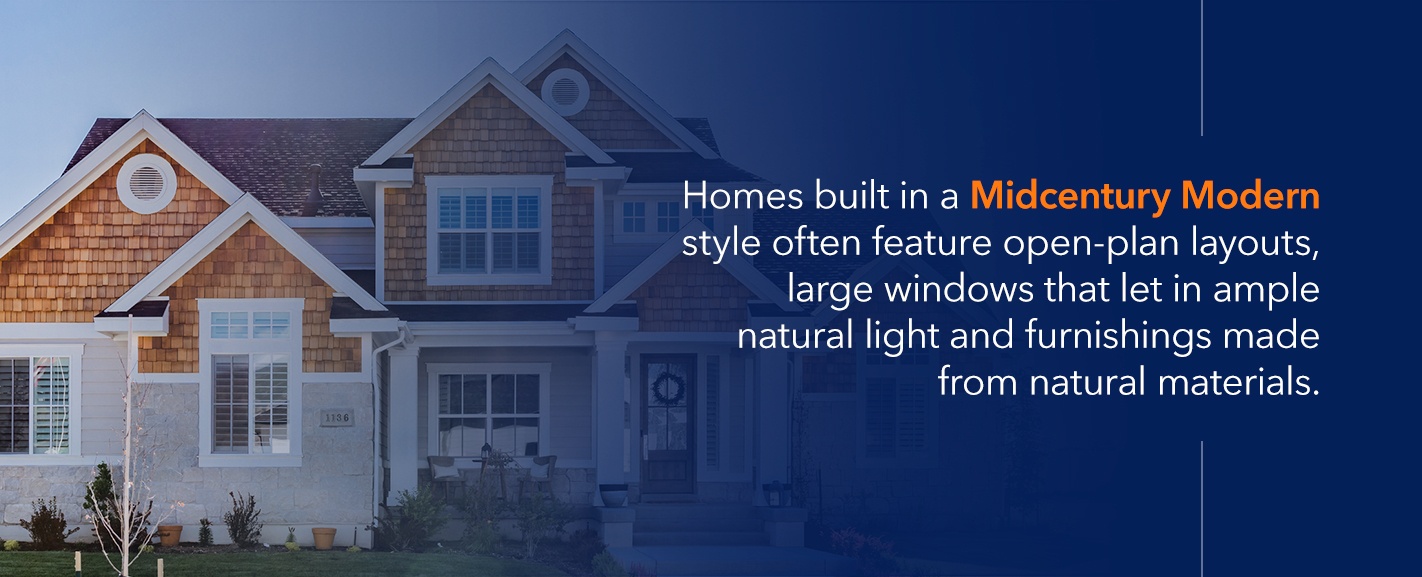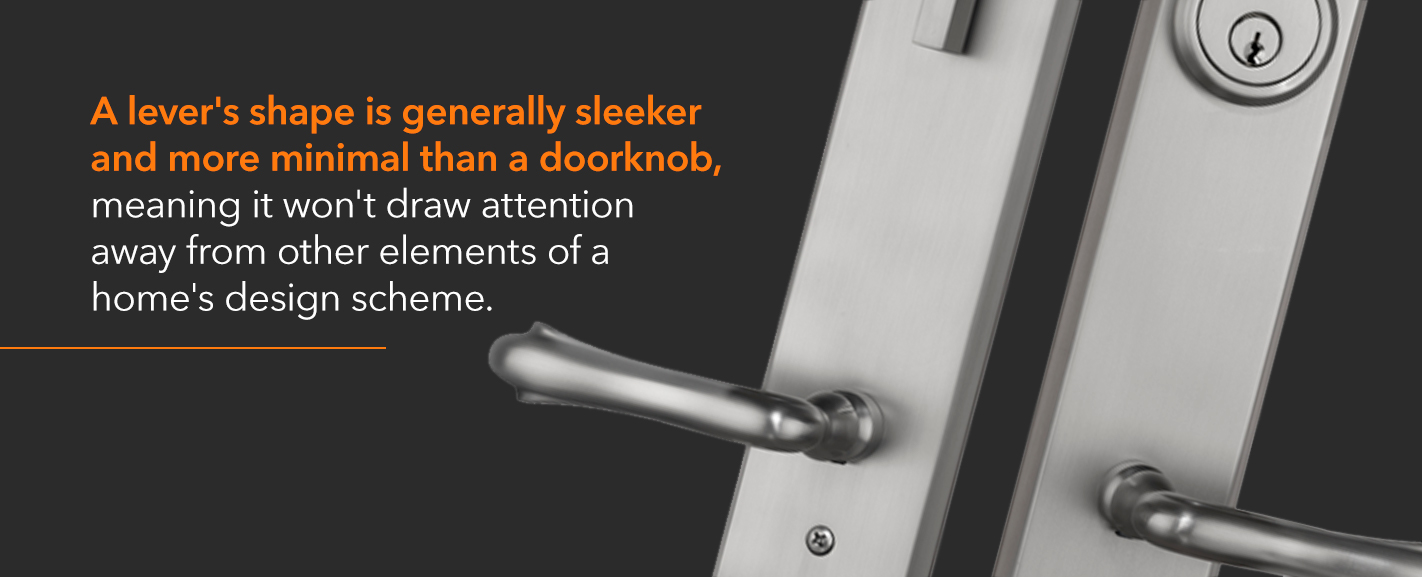A doorknob or door handle plays a critical role in a home’s security by controlling entry into a house. Whether the door is locked or simply pulled tightly shut, the doorknob helps to safeguard the interior space.
Over the centuries, the design and construction of entry door handles have evolved. Although a modern door handle might share some elements with ancient or midcentury door handles, the two share crucial differences. Even door handles from a few decades ago look notably different than the door handles of today.
Let’s look at how the door handle has changed over the years and examine the elements and features of modern doorknobs.
A Brief History of Entry Doors and Handles
Doorknobs and handles have had an extensive history. In ancient times, materials such as animal skins and fabrics were used to create a barrier in front of an entryway. The animal hides didn’t provide the same security as modern doors. They also didn’t have handles or knobs, meaning anyone could come and go.
As homes became more solid and permanent, doors also developed a new form. The Temple of Solomon had a door made from olive wood. The tombs of ancient Egyptians often featured “false doors” made from limestone that were believed to allow the souls of the deceased to pass between the afterlife and the land of the living. The door to the Baptistery of San Giovanni consists of bronze covered with gold.
Even as more durable materials began to be used for constructing doors, most historical doors lacked a key feature — a handle or knob. If an early door had a latch at all, it was usually in the form of a lock, and the door would have a keyhole. To open the door and shut it securely, a person needed to put a key into the keyhole and turn it.
Typically, only the wealthiest people could afford to have both a door and a lock in their homes. Many people simply did without, allowing their doors to close but not latch securely. If they were concerned about safety, they placed a barricade in front of the door to block entry. Some fashioned a makeshift lock called a latchstring. A latchstring usually consisted of a piece of wood that a person could raise to open the door and lower to secure it.

When did knobs and handles come about, then? It wasn’t until the Industrial Revolution in the mid-18th century that door handles and knobs became widespread. The period sparked many technological advancements, making it possible to develop, build and mass-produce door handles. The U.S. Patent Office issued one of the earliest patents for an “improvement in door-holding devices” in 1878 to an inventor named Osbourn Dorsey. In the U.K., Jeremiah and Charles Chubb developed a lever tumbler lock in the early 19th century.
Throughout the centuries, the construction and design of doorknobs and handles have changed. Early knobs were made of wood, then metal. Some knobs, designed to be decorative, were made from glass or ceramic. As time went on, door handles have remained intuitive and easy to operate, but the connected locks have become more secure. People were able to live more comfortably in their homes without the fear of theft or break-ins due to increasingly advanced lock designs.
The look of door handles and knobs has also changed over the years, evolving from a rustic and traditional style to a modern appearance.
When Did Modern Design Become Modern Design?
The phrase “modern design” is slightly confusing. When people hear the word “modern,” they likely assume the time period in question is their own. After all, people refer to modern ways of doing things when talking about the present day. They also describe something as “modern” when it’s new and exciting.
However, Modern design refers to a specific period. Many of the details and aesthetics people associate with Modern design originate from Germany and Scandinavia. As a design style, Modernism is found in many different places, including works of art, architecture and interior design.
Since it is a historical style, Modernism has several fixed elements and features. Some of the defining features of Modern design include:
- Clean lines: Compared to earlier styles, which tended to be more ornate and dramatic, Modernism is all about clean, clear lines and simple details. After the heavy ornamentation of the Victorian era, Modernism must have felt like a breath of fresh air for consumers and designers alike.
- A focus on functionality: Modernism sought to blend form and function. The utility of certain items was key, but so was the aesthetics of those items. Although the design style preferred for items to work as intended, it didn’t necessarily place function over form in every case.
- Earthy, neutral tones: Although there might be a pop of color here and there in a Modernist palette, the focus is on neutrals. Whites and beiges are the primary colors used in Modernism. A bold color or metallic tone might appear every so often to add some visual interest, but bright and shiny would never be the main attraction.
- Natural materials: Modernism also favors natural materials, such as wood and leather. Stone is also a popular material used in Modern design. Wood furniture saw an increase in popularity during the rise of this design era due to its simplicity and versatility.
- Minimalist elements: Another “M” word, minimalism, is closely tied to Modernism. Similar to the style’s rejection of the ornate details of early design periods, Modernism also rejects excess. Thanks to its focus on function, Modern design prefers only to use elements and furnishings that had a purpose. Less is definitely more with this style.
Although the era of Modernism is over, Modern design lives on. The style remains popular among homeowners today. One example of the ongoing popularity of Modernism is the continued interest in and devotion to homes and furnishings that fit into the midcentury modern (MCM) design category. Homes built in an MCM style often feature open-plan layouts, large windows that let in ample natural light and furnishings made from natural materials.
Modern vs. Contemporary
If Modernism refers to a distinct design period, the elements of which are still loved and used today, what does Contemporary design refer to? The term is actually a bit more fluid. Contemporary design can be more difficult to define and describe than Modern design because it is constantly changing. The word “contemporary” means “belonging in the present.” The term comes from the Latin “con,” which means “with,” and “tempus,” which means “time.”
In other words, “Contemporary” design represents present styles and trends. In 30 years, a contemporary style will reflect an entirely new set of values.
Aside from differences in time period, there are some distinct style differences between Modernism and Contemporary design. Those distinctions include:
- Materials used: While Modernism prefers natural materials, like wood and stone, Contemporary design doesn’t shy away from the industrial or synthetic. Metals are big in Contemporary layouts, such as shiny chrome and steel. Plastics and plaster are also popular materials for this aesthetic.
- Colors preferred: Modern design leans toward a neutral palette with some colorful accents. In contrast, “stark” is a good word to describe the Contemporary color palette. It favors white, gray and black — a color scheme that excludes the occasional brighter hues of Modern design.
- Function of furnishings: Modernism values form but favors function. Contemporary design tends to take an aesthetics-first approach. You might find pieces in a contemporary home that serve no purpose other than looking good.
- Shape of furnishings: Contemporary furniture tends to share the same clean lines of Modern furniture, but those lines are also often much softer. You’d be more likely to want to sink down into and relax on an over-stuffed Contemporary couch than you would on a firmer MCM sofa.
- Concept: Since Contemporary design is still evolving, what gets categorized as a Contemporary concept is ever-changing. Modernism is more set in stone conceptually. Certain elements are either Modern or not — there’s little room for debate about what fits into the category.
While there are many differences between Modernism and Contemporary design, there are also many notable similarities between the two. This is partly because Contemporary design borrows many characteristics from Modernism. Some elements the two design styles share include:
- A focus on minimalism.
- A desire for clean lines.
- The use of metal as an accent.
- A preference for natural materials, although Contemporary design does allow for synthetics.
- A preference for open floor plans.
What Is Modern When It Comes to Entry Door Handles?
Although it’s now well over 100 years old, Modern design remains an in-demand and popular style. Interior designers, architects and decorators continue to incorporate elements of Modernism into new homes or existing properties. Those working on giving a home a modern style or refreshing a property with existing Modernist touches will want entry door handles that match the style.
What makes a door handle modern, and how would you recognize a modern doorknob if you saw one? The most popular and trendy door handles have several features in common.

Elements of Modern Door Handle Style
Much like other furnishings and components in a Modern home, Modern door handles usually have the following elements:
-
- Sleek: Modern door handles are sleek and simple. They usually have a straightforward, non-decorative design and are available in sleek finishes. When selecting Modern handles, look for straight shapes rather than rounded ones. The handles should blend in with the rest of the decor, not stand out against it.
- Functional: Functionality is particularly important for Modern-style door handles. They won’t have any extra bells and whistles or ornamentation. The focus is purely on doing their intended job and doing it well. An attractive Modern entryway needs to serve its purpose and uphold its signature aesthetic without comprising either component.
- Smart features: Many Modern door handles also contain advanced technology. Smart locks allow consumers to connect their smartphones to their doors instead of traditional methods. For instance, they might unlock a door using an in-app feature or a simple voice command. Smart locks let users open doors remotely, create entry access codes and limit daily access. They can also send alerts for suspicious activity.
Modern door house handles typically consist of metal. They often feature finishes like:
- Matte black: Matte black is a dark hue that absorbs light instead of reflecting it. It can easily match other color schemes, fitting nicely into Modern homes.
- Bright chrome: Chrome provides an extra shine. Its elegance and bright composition catch attention from across the room.
- Polished nickel: Nickel offers a warm tone as an alternative to gleaming chrome.
Lever vs. Knob
With door handles, there are generally two types to choose from — doorknobs and door levers. Lately, levers are often popular for homeowners, as these door handle models are easier to manipulate. People with limited hand strength can grasp a lever more easily than a knob, for example. This feature adds a layer of accessibility to the door handle’s function, making it both eye-catching and easy to navigate for any individual.
Door levers also work better with Modern design elements than doorknobs. A lever’s shape is generally sleeker and more minimal than a doorknob, meaning it won’t draw attention away from other elements of a home’s design scheme. Doorknobs are often associated with more traditional design styles and might not fit in when installed on an entry door in a Modern house.
Whether building from scratch or updating an existing home, people often look for door hardware that matches the property’s overall design. Modern design was and remains one of the most popular styles in interior design. When manufacturing entry doors, you should produce styles and designs that match current trends and appeal to the largest possible group of buyers. That also means fitting your doors with hardware that complements today’s styles and enhances the doors’ overall quality and functionality.
Contact Rockwell Security Today
As a leading innovator in developing architectural hardware, Rockwell Security manufactures residential and commercial door hardware. We can produce attractive and functional Modern door handles that appeal to designers, decorators and homeowners alike. Find out more about our Modern door hardware by contacting us today.



Trackbacks & Pingbacks
… [Trackback]
[…] Info to that Topic: rockwellsecurityinc.com/what-exactly-is-considered-modern-for-door-hardware/ […]
… [Trackback]
[…] Here you can find 25344 more Information to that Topic: rockwellsecurityinc.com/what-exactly-is-considered-modern-for-door-hardware/ […]
… [Trackback]
[…] Information on that Topic: rockwellsecurityinc.com/what-exactly-is-considered-modern-for-door-hardware/ […]
… [Trackback]
[…] Find More to that Topic: rockwellsecurityinc.com/what-exactly-is-considered-modern-for-door-hardware/ […]
… [Trackback]
[…] Here you can find 53930 more Information to that Topic: rockwellsecurityinc.com/what-exactly-is-considered-modern-for-door-hardware/ […]
… [Trackback]
[…] Read More Info here on that Topic: rockwellsecurityinc.com/what-exactly-is-considered-modern-for-door-hardware/ […]
… [Trackback]
[…] Info on that Topic: rockwellsecurityinc.com/what-exactly-is-considered-modern-for-door-hardware/ […]
… [Trackback]
[…] There you can find 95721 more Info to that Topic: rockwellsecurityinc.com/what-exactly-is-considered-modern-for-door-hardware/ […]
… [Trackback]
[…] Read More Info here on that Topic: rockwellsecurityinc.com/what-exactly-is-considered-modern-for-door-hardware/ […]
… [Trackback]
[…] Find More Info here to that Topic: rockwellsecurityinc.com/what-exactly-is-considered-modern-for-door-hardware/ […]
… [Trackback]
[…] Here you can find 46830 more Information to that Topic: rockwellsecurityinc.com/what-exactly-is-considered-modern-for-door-hardware/ […]
… [Trackback]
[…] Read More on that Topic: rockwellsecurityinc.com/what-exactly-is-considered-modern-for-door-hardware/ […]
… [Trackback]
[…] Information on that Topic: rockwellsecurityinc.com/what-exactly-is-considered-modern-for-door-hardware/ […]
… [Trackback]
[…] There you will find 69401 more Information to that Topic: rockwellsecurityinc.com/what-exactly-is-considered-modern-for-door-hardware/ […]
… [Trackback]
[…] Read More here to that Topic: rockwellsecurityinc.com/what-exactly-is-considered-modern-for-door-hardware/ […]
… [Trackback]
[…] Read More on to that Topic: rockwellsecurityinc.com/what-exactly-is-considered-modern-for-door-hardware/ […]
… [Trackback]
[…] Read More Information here on that Topic: rockwellsecurityinc.com/what-exactly-is-considered-modern-for-door-hardware/ […]
… [Trackback]
[…] Find More to that Topic: rockwellsecurityinc.com/what-exactly-is-considered-modern-for-door-hardware/ […]
… [Trackback]
[…] Information to that Topic: rockwellsecurityinc.com/what-exactly-is-considered-modern-for-door-hardware/ […]
… [Trackback]
[…] Read More on on that Topic: rockwellsecurityinc.com/what-exactly-is-considered-modern-for-door-hardware/ […]
… [Trackback]
[…] Read More to that Topic: rockwellsecurityinc.com/what-exactly-is-considered-modern-for-door-hardware/ […]
… [Trackback]
[…] Find More Information here to that Topic: rockwellsecurityinc.com/what-exactly-is-considered-modern-for-door-hardware/ […]
… [Trackback]
[…] Information to that Topic: rockwellsecurityinc.com/what-exactly-is-considered-modern-for-door-hardware/ […]
… [Trackback]
[…] Info on that Topic: rockwellsecurityinc.com/what-exactly-is-considered-modern-for-door-hardware/ […]
… [Trackback]
[…] Information to that Topic: rockwellsecurityinc.com/what-exactly-is-considered-modern-for-door-hardware/ […]
… [Trackback]
[…] Info on that Topic: rockwellsecurityinc.com/what-exactly-is-considered-modern-for-door-hardware/ […]
… [Trackback]
[…] Information to that Topic: rockwellsecurityinc.com/what-exactly-is-considered-modern-for-door-hardware/ […]
… [Trackback]
[…] Here you can find 12977 additional Info on that Topic: rockwellsecurityinc.com/what-exactly-is-considered-modern-for-door-hardware/ […]
… [Trackback]
[…] Information on that Topic: rockwellsecurityinc.com/what-exactly-is-considered-modern-for-door-hardware/ […]
… [Trackback]
[…] Find More Info here on that Topic: rockwellsecurityinc.com/what-exactly-is-considered-modern-for-door-hardware/ […]
… [Trackback]
[…] Information to that Topic: rockwellsecurityinc.com/what-exactly-is-considered-modern-for-door-hardware/ […]
… [Trackback]
[…] Read More Info here on that Topic: rockwellsecurityinc.com/what-exactly-is-considered-modern-for-door-hardware/ […]
… [Trackback]
[…] Here you will find 89928 additional Info on that Topic: rockwellsecurityinc.com/what-exactly-is-considered-modern-for-door-hardware/ […]
… [Trackback]
[…] Read More Info here to that Topic: rockwellsecurityinc.com/what-exactly-is-considered-modern-for-door-hardware/ […]
… [Trackback]
[…] Info to that Topic: rockwellsecurityinc.com/what-exactly-is-considered-modern-for-door-hardware/ […]
… [Trackback]
[…] Find More Info here to that Topic: rockwellsecurityinc.com/what-exactly-is-considered-modern-for-door-hardware/ […]
… [Trackback]
[…] Find More on that Topic: rockwellsecurityinc.com/what-exactly-is-considered-modern-for-door-hardware/ […]
… [Trackback]
[…] Find More Information here to that Topic: rockwellsecurityinc.com/what-exactly-is-considered-modern-for-door-hardware/ […]
… [Trackback]
[…] Find More on to that Topic: rockwellsecurityinc.com/what-exactly-is-considered-modern-for-door-hardware/ […]
… [Trackback]
[…] Read More on that Topic: rockwellsecurityinc.com/what-exactly-is-considered-modern-for-door-hardware/ […]
… [Trackback]
[…] Find More Info here to that Topic: rockwellsecurityinc.com/what-exactly-is-considered-modern-for-door-hardware/ […]
… [Trackback]
[…] There you will find 88762 additional Info on that Topic: rockwellsecurityinc.com/what-exactly-is-considered-modern-for-door-hardware/ […]
… [Trackback]
[…] Information on that Topic: rockwellsecurityinc.com/what-exactly-is-considered-modern-for-door-hardware/ […]
Comments are closed.